What Baltimore Congregations are Doing to Improve Stormwater Remediation

Late last month on a Sunday evening I attended Blue Water Congregation’s Celebration dinner buffet at St. Anthony’s of Padua Catholic Church on the far east side of the city.
It was immediately evident at St. Anthony’s that pave-over has long been the approach. Environmental stewardship is the new thinking there as plans are being discussed to remediate stormwater runoff on its large site by removing impervious surface and adding rain gardens and bioswales.
84 congregations in the Baltimore-area watershed have had rainwater audits performed. A good number of these are: (a) contemplating; or (b) actually planning stormwater remediation projects on their properties. Among ’em are St. Anthony’s, Freedom Temple AME Zion Church, Chizuk Amuno Congregation, and my own Memorial Episcopal Church.
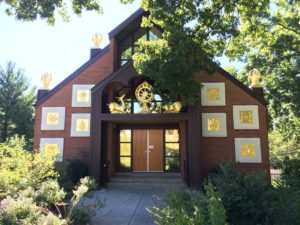 Today’s post is about the amazing work completed earlier this year at Kadampa Buddhist Temple, officially known as Kadampa Meditation Center Maryland (KMC). It has installed 3 rain gardens, a bioswale and a peace garden as of this year, supported by grants of $25K and $5K from two different grant-making non-profits. Those guiding me around the KMC grounds were Rosemary Flickinger and a newer teaching associate of the temple.
Today’s post is about the amazing work completed earlier this year at Kadampa Buddhist Temple, officially known as Kadampa Meditation Center Maryland (KMC). It has installed 3 rain gardens, a bioswale and a peace garden as of this year, supported by grants of $25K and $5K from two different grant-making non-profits. Those guiding me around the KMC grounds were Rosemary Flickinger and a newer teaching associate of the temple.
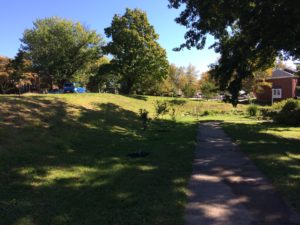 The quantity of stormwater that can pour onto the temple’s site might be imagined in this pix. Perhaps you can detect not only the steep slope of ground but the residential community uphill? Residential communities generate lots of pavement for vehicles, parking and pedestrians. Here the rainfall running onto the temple’s property from these developments is significant.
The quantity of stormwater that can pour onto the temple’s site might be imagined in this pix. Perhaps you can detect not only the steep slope of ground but the residential community uphill? Residential communities generate lots of pavement for vehicles, parking and pedestrians. Here the rainfall running onto the temple’s property from these developments is significant.
A first intercept of the rainwater is the line of newly planted trees, adjacent to the sidewalk, donated by a regional nonprofit, the Baltimore Tree Trust. Their natural watering in the coming growing season is quite assured. And, more for planting are on the way.
Following the sidewalk from the foreground of the pix, down the way it fades from view as it turns to the right (south). That’s where the 2′ x 80′ bioswale has been installed.
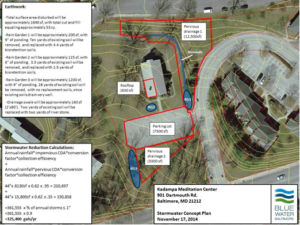
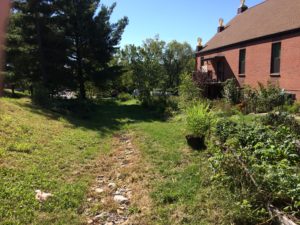
A stormwater concept plan by a landscape architect associated with regional nonprofit Blue Water Baltimore shows a bioswale needed to channel the hillside runoff towards a raingarden adjacent to the temple building.
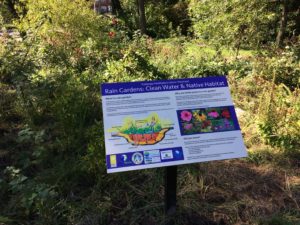 Allowing for the impact of the street serving the town home and apartment communities to the east and north at a higher elevation, and the temple’s own impervious parking lot, a third rain garden was installed. It’s to the south of the parking lot and can be seen in the pix with the rain garden sign.
Allowing for the impact of the street serving the town home and apartment communities to the east and north at a higher elevation, and the temple’s own impervious parking lot, a third rain garden was installed. It’s to the south of the parking lot and can be seen in the pix with the rain garden sign.
You might ask why the temple is engaged so extensively in treating stormwater before it runs into the municipal sewer system? As best a Christian can describe it, it’s about the inner mandala flowing into the outer mandala.
What’s a mandala?
In it’s simplest form as used in Kadampa Buddhism, it’s “an offering of the entire universe visualized as a Pure Land, with all its inhabitants as pure beings.” Pure beings have enlightened minds stemming from 4 special wisdom realizations that through a spiritual path contain the ultimate truth of life’s ways.
So, springing from the inner mandala, the enlightened mind, is the outer mandala, the external world dimension of Pure Land peopled by pure beings. All inhabitants (all life in the biosphere) are elements of the outer mandala. An actual landscape surrounding the temple that’s respectful of the sanctity of all living organisms in nature, and well-maintained, is a joyful representation of a divine outer mandala.
One of the thrusts of this post becomes a question. For its restorative effects on earth, what can you do, from a congregational or corporate standpoint to a personal one, to help manage stormwater on site?
It’s a vexing problem in more densely packed urban areas where municipal stormwater drainage and treatment often cannot presently keep up with the “paved-over” effect. Much less in our new era of extreme weather events.
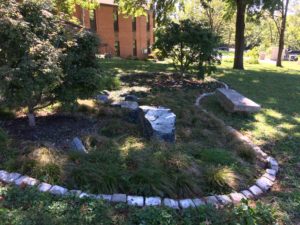 Slip into Kadampa’s peace garden shown here. It may be a good place for imagining your answer.
Slip into Kadampa’s peace garden shown here. It may be a good place for imagining your answer.
If living in the mid-Atlantic region, one source you should check out for help in actualizing what you imagine for your congregation or other organization is Interfaith Partners for the Chesapeake of which Blue Water Congregations is an initiative.